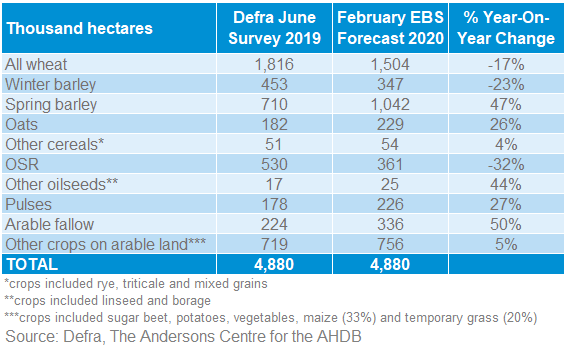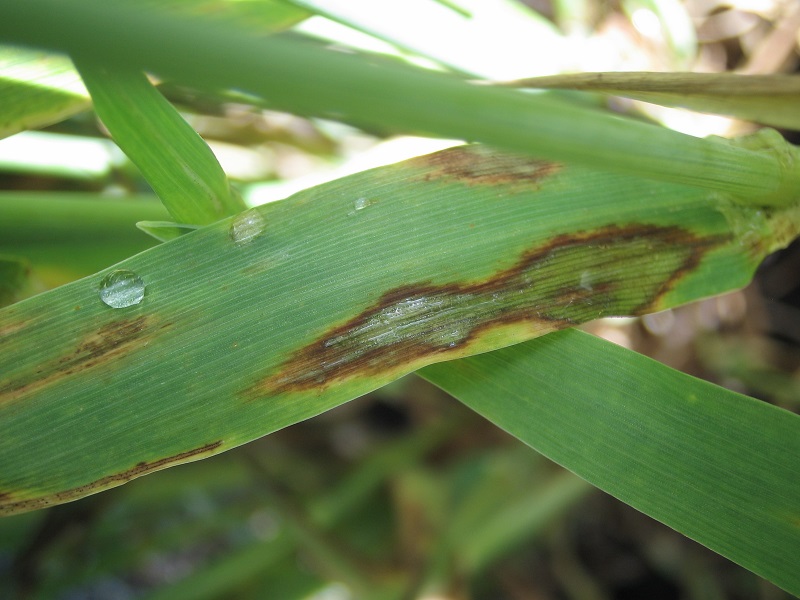With a larger-than-normal area of spring barley anticipated this year, disease control will be essential for getting the best from the crop. CPM spoke to three pioneering growers about how a modern SDHI has been helping them tackle the most yield-robbing diseases in barley crops.
By targeting the crop at the late T2 timing, we’ve found it really has helped to just hold the crop clean until harvest.
By Charlotte Cunningham
According to the AHDB Early Bird planting survey, the spring barley area is expected to increase significantly this year at the expense of wheat.
For those growers with less experience of the crop, this will no doubt cause some uncertainty, especially on the disease front.
What’s more, with the loss of chlorothalonil imminent, disease control across the spectrum could be more challenging this year — even for the most experienced growers.

According to the AHDB Early Bird planting survey, the spring barley area is expected to increase significantly this year at the expense of wheat.
So is there anything out there to help give growers the upper hand against some of the trickiest diseases this season?
Syngenta’s SDHI fungicide, Elatus Era (benzovindiflupyr+ prothioconazole), caught the attention of the industry a few years ago and while initially it was predominantly used in wheat crops, since its launch, Syngenta has explored its capabilities in barley — which has yielded some pretty impressive results too.
While taking a punt on something new in an already difficult year may seem like a very risky strategy, three progressive growers across the country— all with different disease pressures— have found that optimising Elatus Era within their programme has helped them stand up to barley diseases on farm.
Ramularia ramifications in Norfolk
With just under half of his 400ha planted to malting barley, north Norfolk grower, Jonathan Pye, found himself burdened with ramularia issues. “We run about 110ha of Flagon and Craft winter malting barley and about 60/70ha Laureate spring barley. Like most people with large areas of the crop, we began to see much more in the way of ramularia and so started using a chlorothalonil product.”
However, Jonathan was looking for something to partner with that and his agronomist pointed him in the direction of Elatus Era. “I’m very much guided by my agronomist. The benefit of him being independent is that there’s never any product bias or pressure on us to use a certain thing. Instead, we can make decisions based on how well the product works.”
Elatus Era was brought in as a partner at T2 to Jonathan’s existing CTL programme, — replacing his previous strobilurin + CTL treatment approach— with the potential to use it at either T2 or at awn emergence, though so far it has only been used within a tank-mix. “We’ve now used Elatus Era for two years and although I wouldn’t want to strictly attribute it to big yield improvements, what I am certain about is that our crops look much cleaner than they did under the previous regime,” he adds.
With the ability to tweak dose rates, the flexibility of the product is another strong point for Jonathan. “Every year is different, so if we feel our disease pressure is also different, we have the flexibility to tailor our usage accordingly.”
As well as finding benefits within his barley area, Jonathan has also been optimising the product in his wheat. “We’ve also been including Elatus in our wheat programme, also at the T2 timing, and I would say the crops do look reasonably clean as a result. Up until two years ago I was using another product to provide control, but now being able to use just one product on all of our cereals makes life a lot easier.”
In terms of cost, while it’s not the cheapest product on the shelf, the benefits pay for themselves, he adds. “Last year we applied it to our winter barley at a rate of 0.6 litres/ha at T2 and this worked out at about £3.50/t — £28/ha.
“It’s not cheap, but the crop is cleaner and effectively, a cleaner crop should be a better yielding crop, which reaps financial rewards in itself.”
Net blotch nuisance in Hampshire
Down south in Winchester, Simon Newberry also came across disease issues due to a heavy rotation of continuous spring barley. “We’ve got about 700ha in total here and much of it is put to spring malting barley. This year, we’re growing Laureate and RGT Planet, but we do tend to switch it up a bit. Last year, we grew Diablo for distilling, for example.”
In terms of establishing the crop, Simon was previously leaving stubble over winter and then min-tilling straight into it the following season, which unfortunately led to increased pressures from net blotch.
With the pathogen being one that’s predominantly trash-borne, it was largely the infected stubble and debris that exacerbated the disease impact.
Not only does net blotch affect yield, but also grain quality by increasing screenings and therefore, the risk of crop rejection for malting— not the ideal scenario for someone with a large percentage of their crop destined for malting barley markets, he adds.
At the peak of its epidemic in 2015-2016, Simon estimates a yield loss of about 40% in his barley crops as a result of the net blotch issues.
As a result, he looked into cultural methods of keeping the disease at bay — which predominantly involved switching up his rotation — however, following success with controlling rust in his wheat crop after using Elatus Era, he decided to try it on his barley too to see if he could add in another element of control. “By targeting the crop at the late T2 timing, we’ve found it really has helped to just hold the crop clean until harvest, and we’re averaging about 8t/ha here on our light chalk soils.”
Again, cost is something to factor in, however, Simon says he opts for a half rate dosage to make it more cost efficient and only uses Elatus Era in targeted situations.
“We’re basically now just using it where we’ve got known disease pressures. Not only does this help us keep a lid on costs, but also helps us to give a bit more protection and longevity to the new mode of action we’ve brought in.
“I’m really pleased with the results we’ve seen, in both our barley and wheat.”
Prevention better than cure in Oxon
For Oxon grower, Rufus Dudfield, it’s all about prevention— rather than cure— when it comes to his barley disease management strategy.
Rufus grows a rotation of winter wheat, OSR peas and of course, barley (winter and spring) which are used to supply local markets. “In terms of our winter cropping, we tend to grow the feed variety Glacier for a local feed mill,” he says. “Like most people, we went into spring barley for the weed control benefit and normally grow Planet which we always try and get to malting spec— again for a local market —though we do have issues with nitrogen levels.”
Though there were no specific disease burdens on the 650ha farm near Banbury, Rufus has committed to getting the best out of his crops by implementing a prevention strategy within his chemical programme.
At the helm of this is Elatus Era, which he’s now used over two seasons. “I have to say that although it looked good when we trialled it initially, when I treated the whole barley crop, we did notice an increase in yields.”
To quantify this, Rufus reckons he’s seen an average yield increase of about 0.3t/ha in his winter barley crops since incorporating Elatus Era into his programme. “It [Elatus Era] has definitely been a contributor to increased yield, though it’s important to recognise that there are lots of different variables that can contribute to or reduce yield, so it’s not necessarily a silver bullet. But it has helped.”
When searching for an SDHI product, with tight margins in mind, cost weighs heavily on decision making, he says. “With other products on the market, the decision ultimately came down to cost, and we could buy and optimise Elatus much more cost-effectively than some others.”
However, this competitively priced option doesn’t compromise on control, he adds. “It’s a great product as it contains prothioconazole, which is strong on a spectrum of barley diseases and the Solatenol SDHI component is great for protection against the likes of rhynchosporium.
“It also tank-mixes well, so it’s simple and flexible to use.”
Today, Rufus optimises Elatus Era as a preventative measure at T1— with some experimenting at T0— and follows up with a more traditional strobilurin/azole product. “The way I see it, I’d rather get a product on that I know works before any problems arise. Since we’ve brought it into the programme, we’ve had no real major issues with disease. It seems to be keeping any threats to the crop at bay.”
Getting the best out of Elatus in barley
Elatus Era is a benzovindiflupyr-based foliar SDHI which is active against a broad spectrum of barley diseases, including net blotch, rhynchosporium, ramularia (where sensitive) and brown rust.
With an increased crop area and several potential new growers this season, the convenience of a product with a proven ability in both wheat and barley should be attractive, according to Syngenta.
But for barley crops specifically, how can growers get the best out of Elatus Era?
With claimed powerful control of key barley diseases, Elatus Era is said to be able to replace bixafen + prothioconazole at one of the fungicide timings. For conventional winter barley, the best timing is T1, as it’s important to keep the lower leaves clean due to the way barley builds its yield, says Iain Hamilton, field technical manager at Syngenta. “For hybrid barley, the best timing is T2, protecting the larger flag leaves, which drive yield. In both cases, inclusion of a multisite – such as Bravo (Chlorothalonil) or folpet – should be considered for resistance management.”
In the case of spring barley, the best timing is also T2 and again, a multisite should be considered as part of the risk management strategy, adds Iain. “It’s always important to inspect crops to assess disease development immediately before spraying.
“Best results will be achieved from applications made as a protectant treatment, or in the earliest stages of disease development following a disease risk assessment or the use of appropriate decision support systems.”
Pioneer Pointers: Elatus Era
Whenever something new appears on the market, there are a select few who take the initiative and give it a go. These are the pioneers who manage change and take a step forward, not just for themselves but for the entire industry. The rest of us wait for the informed view to point us in the right direction.
CPM would like to thank the pioneers who have shared their views on Elatus Era in this article, sponsored by Syngenta. Elatus Era is a major new weapon in the fight against cereal diseases, combining Syngenta’s latest foliar SDHI, benzovindiflupyr (also called Solatenol), with the respected triazole, prothioconazole.
As well as powerful disease control, it has also provided consistent yield benefits and complete protection of leaves against disease in wheat, with similarly impressive results in barley. With full approval for malting barley and good results in the AHDB fungicide performance trials, growers should consider using it in barley crops this year.




